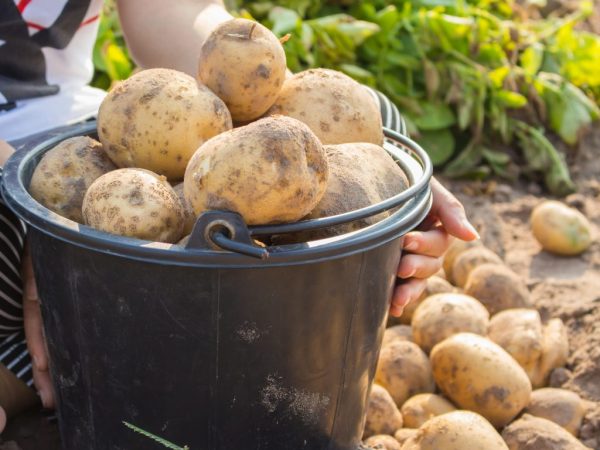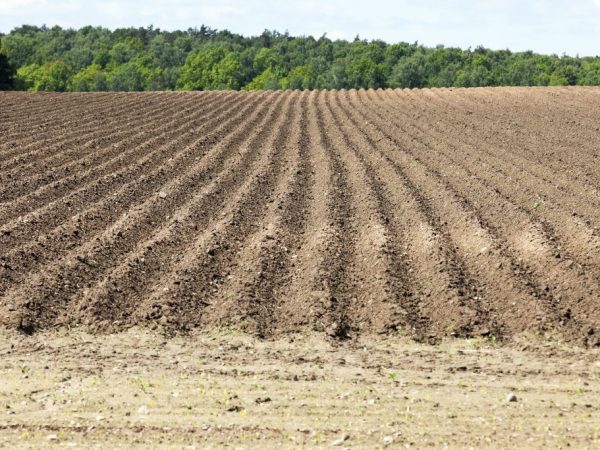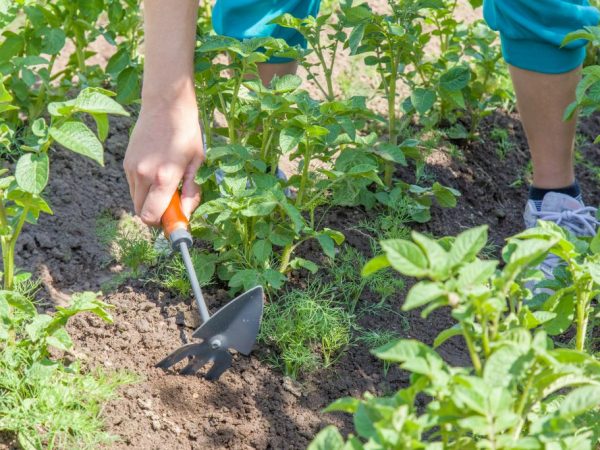Description of Timo's potatoes
Timo potatoes are a Finnish hybrid with good taste. Within 55 days from the moment of planting, the tubers become suitable for human consumption. The high-yielding variety is widespread among farmers in the post-Soviet space.

Description of Timo's potatoes
Characteristics of the variety
The Timo potato variety belongs to the early ripening varieties of table purpose. Perfect for growing even in unfavorable conditions in the northern regions of Russia, although the yield here will be lower than in the southern regions. Timo Hankkiyan's potatoes are perfectly adaptable to any conditions. It tolerates drought well, and feels fine in a humid environment. Not whimsical to the characteristics of the soil. Productivity and quality increase in sandy loam soil.
The tendency to degeneration of the variety is quite low, so the seed can be used for a long time without changing. Refers to the universal varieties. The qualitative characteristics of the fruits allows them to be used for the preparation of all kinds of dishes. After heat treatment, the tubers do not fall apart and do not lose their color.
Description of the plant
Characteristic:
- sprawling bush, straight stem;
- foliage is large, light green;
- inflorescences are compact;
- flowers are bluish-purple in color.
Features of the fetus
Potatoes of this variety have the following qualities:
- oval roots with a weight of 70 to 130 g;
- the peel is glossy, smooth;
- on the cut, the flesh is creamy yellow;
- the starch level in the fruit is 14.2%.
Growing
Timo Khankkiyan's potatoes are undemanding nightshade crops. Not picky about the composition of the soil. Responds well to regular feeding. It is recommended to grow a crop in areas previously seeded with green manure: flax, winter, annual herbaceous plants.
Landing is carried out in mid-April, under favorable weather conditions. In the northern regions, the landing period is postponed to the end of May. The culture needs constant loosening of the soil.
Soil preparation
As a standard, they begin to prepare the soil in the fall. Deep cultivation with fertilization is carried out. In the autumn, manure or combined vitamin formulations are usually applied.

The soil needs to be fertilized
A month before planting, deep cultivation is carried out again and another portion of organic matter is introduced. Depending on the planting method, markings are made. The planting method is selected according to the type of soil. There are 3 methods:
- smooth - the standard version for a shovel (landing depth 10 cm);
- trench - used on light sandy soils (potato planting depth 12-15 cm);
- ridge - used on heavy soils (seeding depth 15 cm).
Often this type of potato is used in non-standard growing options. One of the interesting methods is container growing.The method allows you to get from one bush about a bag of root crops. On low fertile soils and small areas, it is recommended to grow Timo's potatoes using the barrow method. A circular embankment is made in a small area and several bushes are planted in a circle.
Seed preparation
Seed material requires preliminary processing. After harvesting, the tubers are immediately separated for planting. They are kept in a sunny room for several days so that they turn green. This move helps keep the tubers from mice. About 30 days before planting, the tubers should be removed from the cellar and disinfected.
Root vegetables are kept in a warm room for several weeks. After about 21 days, sprouts will appear. At this stage, it is necessary to reject tubers that have not sprouted, as well as potatoes with thin filamentous sprouts. To accelerate growth, they practice soaking the planting material in a solution of superphosphate and nitrate. After that, a procedure is carried out for dusting with wood ash.
Landing
When the soil layer warms up to 8-10 ℃, you can start planting the culture in the ground. Before that, you need to plow the soil. It is very important that the ground is moist.
The tubers are laid so that the sprouts do not break when the hole is covered with soil, if they are too long. After about 10-14 days, the first shoots will appear. From this moment on, in order to increase yields and improve quality indicators, you need to follow the rules of care.
How to care
The first thing to take care of is watering. Timo Hankkiyan is a drought-tolerant variety. In some regions, it will be enough to water the crop three times. The main thing is not to allow the soil to dry out during flowering.
Typically, the first watering is carried out during the active growing season. It is not necessary to fill the area immediately after planting, there is still enough spring moisture in the soil. The second time the potatoes are watered in the flowering phase. In the future, they are guided by the dryness of the soil. 20-30 days before harvesting, watering is completely stopped.
Hilling and weeding

Plants must be spilled
The procedure is carried out necessarily when the planting material is embedded to a depth of 5-10 cm. Hilling is not carried out at all when:
- severe drought;
- ridge planting.
The procedure is usually carried out three times. After strong shoots of 10 cm appear, they are sprinkled with earth for 8 cm. This procedure is necessary to protect the plants from frost. When the sprouts rise another 10 cm, the next stage of hilling is performed. In the same period, loosening of the soil is carried out in the inter-row space.
Weeding should be done regularly after watering and rainfall. This avoids the formation of a hard crust on the soil surface. The higher the soil moisture level, the deeper the soil needs to be loosened.
Fertilizer
An important factor affecting the yield is regular, timely fertilization. The culture is fertilized three times during the entire growth period. When the tops reach 10 cm, they are fed with organic matter. You will need about 500 ml of liquid mullein per bush. Top dressing is carried out after watering or rain.
At the time of budding, a second feeding is carried out. At this stage, it is recommended to add potassium compounds or ash. Potassium helps to speed up flowering. At the flowering stage, organic matter is introduced to accelerate the growth of the root system. To do this, add a glass of mullein and 2 tablespoons to 10 liters of water. superphosphates.
Yield
Finnish potatoes can be eaten 50 days after planting. The crop is completely harvested after 70 days. One tuber weighs about 130 g. The maximum yield is 330 centners per hectare.
The tubers are well stored, despite the fact that Timo Hankiyan is an early variety. Up to 90% of the harvest is preserved. Potatoes retain their presentation for a long time, which allows them to be used for commercial activities. The attractive appearance is retained even with mechanical damage.
Harvesting
The harvesting period is determined by the state of the tops. If it begins to wither or turn yellow, you need to dig out a potato bush and carefully examine the tubers. A strong peel is a signal for action.
After digging up, the nightshades are left in the sun for 2 hours, and then sorted and put in boxes. It is not recommended to keep the potatoes in direct sunlight for longer, otherwise the production of a toxic substance will begin in it. In boxes, potatoes remain in a warm room for another month.
The room temperature should be gradually reduced to 2-4 ℃. After a month, the tubers should be sorted out again and unsuitable for storage. After that, you can lower the roots into the cellar for the whole winter. In the vegetable store, an increased air humidity should be maintained at the level of 80-90%.
Pests and diseases
Description of the variety Timo Hankkiyan says that the plant is quite resistant to many diseases. However, experienced farmers don't think so. Among the gardeners' reviews, there are often complaints that the Finnish representative of the nightshade is more vulnerable to wireworm attacks than others, and when re-grown, it quickly becomes infected with late blight. The species is not resistant to the golden nematode.
There is no nightshade culture that Colorado beetles do not eat. To prevent the attack of pests and the appearance of fungi, it is recommended to disinfect the tubers before planting. If you plan to plant potatoes for the second season, you need to take care of additional protection against late blight. Often the drug Fitosporin is used for these purposes.
findings
Description of the qualitative characteristics Timo Hankiyan allows growing the variety in soil with any composition. The variety tolerates drought and high humidity well. It is characterized by medium resistance to late blight. It is often used for cultivation in non-standard ways.
The highest yield is observed in the southern regions. The big advantage is high resistance to mechanical damage, preservation of the presentation for a long time. During heat treatment, the potato does not change color and keeps its shape perfectly, which allows it to be used for cooking many dishes.
Of the shortcomings, gardeners note low resistance to damage by golden nematode and wireworm. In the northern regions, potatoes give a low yield, about 200 centners per hectare. When re-grown in the middle lane, the risk of late blight infection is significantly increased. However, if you carry out the correct treatment of planting material with insecticides, you can avoid many problems.


